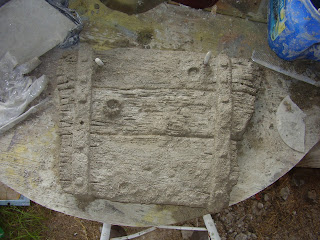Working toward re-making the garden gate, which was an earlier attempt at faux wood using papercrete. The gate hangs on a fence post, so weight is a big consideration. That first effort was made of vermiculite, cellulose insulation, and cement. This new mix is two parts vermiculite, one part cement, and one quarter part builder’s lime. I started with one part water, but the vermiculite seemed to absorb a lot, and I had to add water was I worked. I made the armature for this small experiment out of Styrofoam insulation and chicken wire. It will be a sort of hanging plaque, but I am more interested in seeing if the mix, sans paper, will work for the gate, and how heavy the finished product will be. The vermiculite mix handled almost as well at that made with sand. It was coarser, but not as much as papercrete, and I could add more details than with papercrete.


